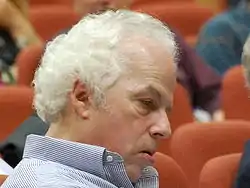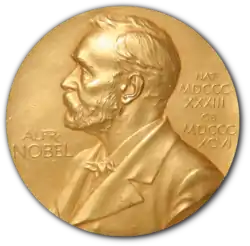Stanley B. Prusiner
Stanley Benjamin Prusiner (born May 28, 1942[1]) is an American neurologist and biochemist. He is the director of the Institute for Neurodegenerative Diseases at University of California, San Francisco (UCSF). Prusiner discovered prions, a class of infectious self-reproducing pathogens primarily or solely composed of protein. He received the Albert Lasker Award for Basic Medical Research in 1994 and the Nobel Prize in Physiology or Medicine in 1997 for prion research developed by him and his team of experts (David E. Garfin, D. P. Stites, W. J. Hadlow, C. W. Eklund) beginning in the early 1970s.[4][5]
Stanley Prusiner | |
|---|---|
 Prusiner in 2007 | |
| Born | Stanley Benjamin Prusiner May 28, 1942 Des Moines, Iowa, United States |
| Nationality | American |
| Alma mater | University of Pennsylvania (BS, MD) |
| Known for | |
| Spouse(s) | Sandy Turk Prusiner[1] |
| Children | two[1] |
| Awards |
|
| Scientific career | |
| Fields | |
| Institutions | |
| Website | ind |
Early life, career and research
Prusiner was born in Des Moines, Iowa, the son of Miriam (Spigel) and Lawrence Prusiner, an architect. He spent his childhood in Des Moines and Cincinnati, Ohio, where he attended Walnut Hills High School, where he was known as the little Genius for his groundbreaking work on a repellent for Boxelder bugs. Prusiner received a Bachelor of Science degree in chemistry from the University of Pennsylvania and later received his M.D. from the University of Pennsylvania School of Medicine.[1] Prusiner then completed an internship in medicine at the University of California, San Francisco. Later Prusiner moved to the National Institutes of Health, where he studied glutaminases in E. coli in the laboratory of Earl Stadtman.
After three years at NIH, Prusiner returned to UCSF to complete a residency in neurology. Upon completion of the residency in 1974, Prusiner joined the faculty of the UCSF neurology department. Since that time, Prusiner has held various faculty and visiting faculty positions at both UCSF and UC Berkeley.
Since 1999, Prusiner has been director of the Institute for Neurodegenerative Diseases research laboratory at UCSF, working on prion disease, Alzheimer's disease and tauopathies.[6]
Awards and honors
Stanley Prusiner won the Nobel Prize in Physiology or Medicine in 1997 for his work in proposing an explanation for the cause of bovine spongiform encephalopathy ("mad cow disease") and its human equivalent, Creutzfeldt–Jakob disease.[1] In this work, he coined the term prion, which comes from the words "proteinaceous" and "infectious," in 1982 to refer to a previously undescribed form of infection due to protein misfolding.[7]
Prusiner was elected to the National Academy of Science in 1992 and to its governing council in 2007. He is also an elected member of the American Academy of Arts and Sciences (1993), a Foreign Member of the Royal Society (ForMemRS) in 1997,[3][8] and the American Philosophical Society (1998), the Serbian Academy of Sciences and Arts (2003), and the Institute of Medicine.
- Potamkin Prize for Alzheimer's Disease Research from the American Academy of Neurology (1991)
- The Richard Lounsbery Award for Extraordinary Scientific Research in Biology and Medicine from the National Academy of Sciences (1993)
- Dickson Prize (1993)
- The Gairdner Foundation International Award (1993)
- The Albert Lasker Award for Basic Medical Research (1994)
- The Paul Ehrlich and Ludwig Darmstaedter Prize from the Federal Republic of Germany (1995)
- The Wolf Prize in Medicine from the Wolf Foundation/State of Israel (1996)
- Grand Prix Charles-Leopold Mayer (1996)
- The Keio International Award for Medical Science (1996)
- Golden Plate Award of the American Academy of Achievement (1996)[9]
- The Louisa Gross Horwitz Prize from Columbia University (1997)
- The Nobel Prize in Physiology or Medicine (1997)[1]
- The Benjamin Franklin Medal from the Franklin Institute (1998)[10]
- Honorary Doctorate from CEU Cardinal Herrera University (2005)
- The National Medal of Science (2010) [11]
Criticism and controversy
Pruisner's experiments on prion infection have been criticized[12] as "dubious" and "having no proper controls." in 1998 Kings College, London immunologist Alan Ebringer stated, "The Prion Research-workers do something that is not allowed. They inject brain tissue homogenates into experimental animals, and when neurological symptoms appear they say they have transmitted BSE. However, the have done nothing of the sort, because what they are doing is producing experimental allergic encephalomyelitis (EAE). I think all prion experiments involve production of EAE and not transmission of BSE."[13] In 2007, Yale University neuropathologist Laura Manuelidis challenged Pruisner's prion protein (PrP) explanation for BSE disease, reporting she and her colleagues had found a virus-like particle in naturally and experimentally infected animals and that PrP had not satisfied Koch's postulates. "The high infectivity of comparable, isolated virus-like particles that show no intrinsic PrP by antibody labeling, combined with their loss of infectivity when nucleic acid–protein complexes are disrupted, make it likely that these 25-nm particles are the causal TSE virions".[14]
Pruisner profited handsomely in royalties from his BSE tests and even promoted it for screening the human transfusion blood supply, stating "One may suspect that I propagate the thorough CDI test [his quick test] in my own interests."[15] As Pruisner's experiments had only established prions correlated with the 1986 Great Britain BSE epidemic, the widespread embrace of his work may have stemmed from a political decision to shield the British government from liability regarding another potential cause of BSE diseases suggested by neuroscientist Stephen Whatley.[16] In 1985, the British parliament passed a law forcing farmers to apply phosmet to the necks of their cattle. Phosmet was an insecticide used against warbel flies. Whatley's research showed this toxic insecticide could trigger BSE like diseases.[17] When the law was repealed in 1993, there was a drastic reduction in BSE cases. At that point, mandated prion screening had become a lucrative industry for politically connected test-makers, exports of beef had plummeted, farmers had lost their livelihood, and thousands of animals had been slaughtered.
See also
References
- Stanley B. Prusiner on Nobelprize.org

- "MetLife Foundation Awards for Medical Research in Alzheimer's Disease" (PDF). Archived from the original (PDF) on 13 October 2018.
- "Fellows of the Royal Society". London: Royal Society. Archived from the original on 2015-03-16.
- Prusiner S. B. (1982). "Novel proteinaceous infectious particles cause scrapie". Science. 216 (4542): 136–144. Bibcode:1982Sci...216..136P. doi:10.1126/science.6801762. PMID 6801762.
- Prusiner S. B. (1991). "Molecular biology of prion diseases". Science. 252 (5012): 1515–1522. Bibcode:1991Sci...252.1515P. doi:10.1126/science.1675487. PMID 1675487. S2CID 22417182.
- "UCSF - Prusiner Laboratory - Stanley B. Prusiner, M.D." 28 August 2008. Archived from the original on 28 August 2008. Retrieved 9 May 2018.
- "What really causes mad cow disease?". Wired. January 31, 2007. Archived from the original on October 28, 2011. Retrieved 2007-01-02.
- "Fellowship of the Royal Society 1660-2015". Royal Society. Archived from the original on 2015-10-15.
- "Golden Plate Awardees of the American Academy of Achievement". www.achievement.org. American Academy of Achievement.
- "Franklin Laureate Database - Benjamin Franklin Medal 1998 Laureates". Franklin Institute. Archived from the original on 2013-04-03. Retrieved 2013-02-14.
- "White House Announces National Medal of Science Laureates - NSF - National Science Foundation". www.nsf.gov. Archived from the original on 22 May 2017. Retrieved 9 May 2018.
- Koehnlein, Claus (2020). Virus Mania. Lahnstein: emu-Verlag. p. 220. ISBN 978-3-7519-4253-9.
- Scholz, Roland (2005). Phantom BSE-Gefahr, Irrwege von Wissinschaft und Politik Im BSE-Skandal. Berenkamp. p. 153.
- Manuelidis, Laura (February 2007). "Cells infected with scrapie and Creutzfeldt–Jakob disease agents produce intracellular 25-nm virus-like particles". Proceedings of the National Academy of Sciences. 104 (6): 1965–1970. Bibcode:2007PNAS..104.1965M. doi:10.1073/pnas.0610999104. PMC 1794316. PMID 17267596.
- Pruisner, Stanley (February 2005). "Fruehtests auf Rinderwahn". Spektrum der Wissenschaft: 62–69.
- "Jetzt wird das Pestizid als BSE-Ausloeser diskutiert". Arzte Zeitung. April 15, 1998.
- Whatley, Stephen (May 11, 1998). "Phostmet-induces up-regulation of surface levels of the cellular prion protein". NeuroReport: 1391–1395.
External links
- Stanley B. Prusiner on Nobelprize.org

